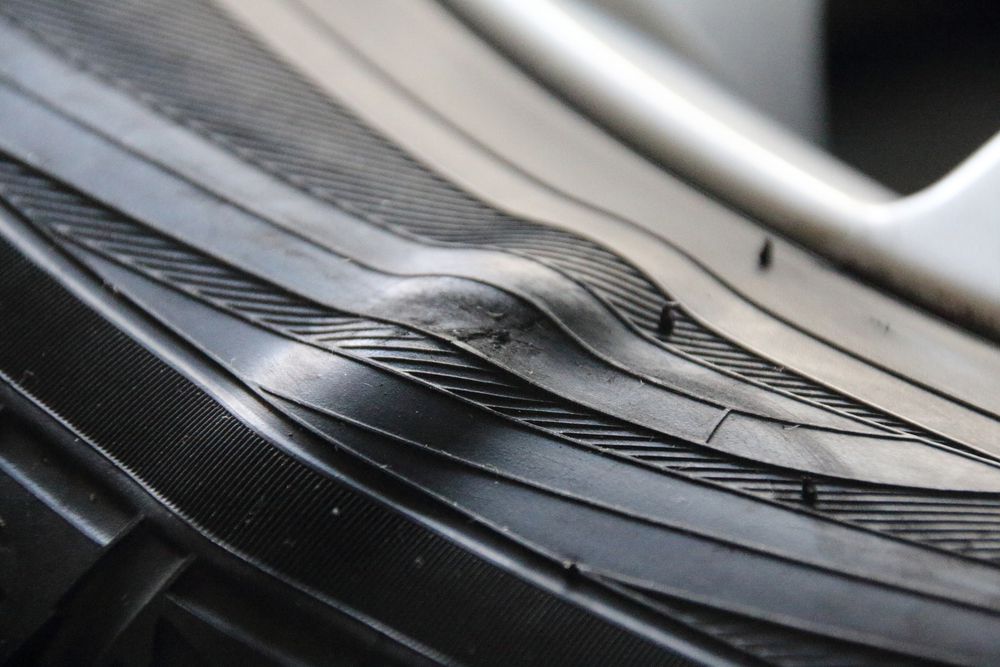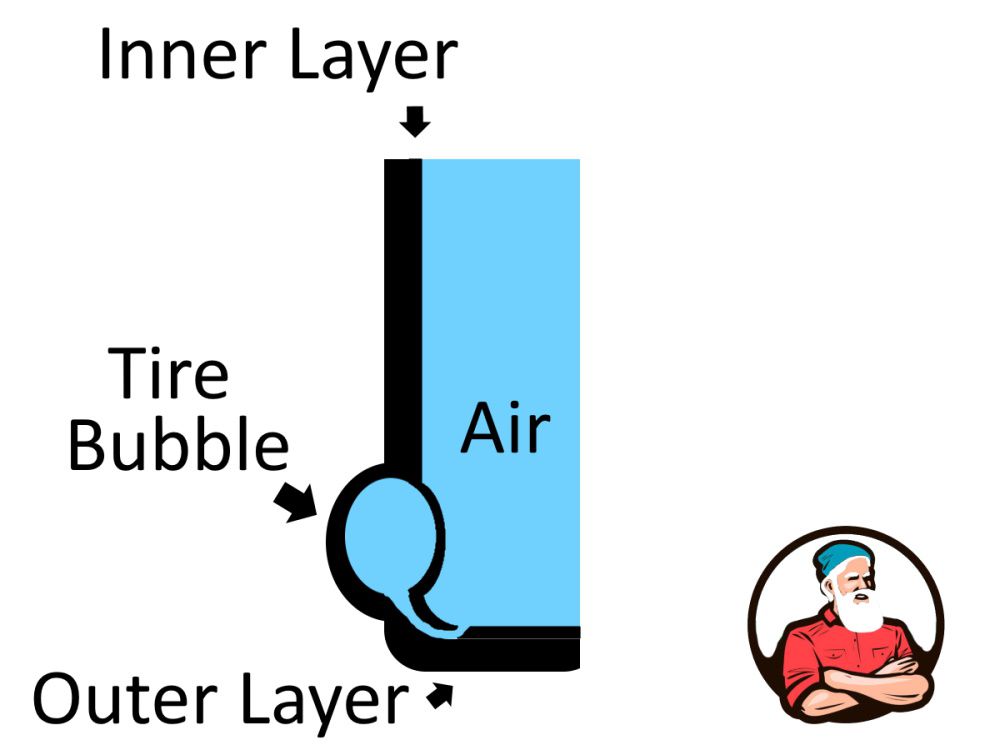As a car owner, you may have noticed tire sidewall bubbles and wondered what causes them and whether they are safe.
Tire bubbles are caused by damage to the inner lining of the tire. Air will then get under the inner lining and pool in a bubble under the outer layers of the tire. The damage to the inner layer of the tire can be caused by impacts like hitting potholes, speed bumps, curbs, or by driving with too heavy of a load or old and worn-out tires.
Tire bubbles severely compromise the tire's structure and are a serious safety hazard.
Tire bubbles cannot be repaired; the only solution is a new tire.
Please keep reading to learn more about the risks of driving on a bubbled tire, how to avoid this issue, and what it costs to fix it (replace the tire).
 Tire bubble on a fairly new tire.
Tire bubble on a fairly new tire.
Why Do Tires Get A Bubble?
Tire bubbles result from a failure of the tire's internal structure.
A car's tire is constructed of multiple layers. The inner layers hold air pressure, while the outer layers are made to withstand the wear and tear of contact with the driving surface.
If the inner layer of a tire is damaged, air can seep inside, and over a short period, it will pool in a weak spot.
Tire sidewalls are particularly susceptible to tire bubbles because of the stress, which causes a large amount of flexing imparted on the sidewall while driving.
If you notice a bubble in your car tire, it's often due to a separation of the layers of rubber, which sends a bubble of air up to the tread.
This separation usually occurs due to weak or damaged inner layers, which could be the case for various reasons.
Bubbles in tires could be due to one of several issues, including the following:
- Low tire pressure
- Driving over potholes, road divots, curbs, sidewalks, or other obstacles
- Manufacturing defects
- An overloaded vehicle
- Driving on old or worn-out tires
Most often, these "bubble" deformations in car tires arise on the sidewall area of the tire or somewhere on the tire's tread.
 Tire bubble diagram
Tire bubble diagram
How Do I Stop My Tires From Bubbling?
Once a tire bubble starts forming, there is no way to stop it.
Luckily, there are several practical ways to prevent tire bubbles from forming in the first place that you can achieve without the help of a mechanic.
The best way to prevent tire bubbles is to purchase high-quality tires from a reputable tire dealer. In addition, ensure the tire was manufactured recently. A car tire will deteriorate over time, even sitting in a warehouse.
Once you have your high-quality tires, the next thing to do is maintain the correct tire pressure in the car tires. You can find tire pressure recommendations in your owner's manual, the inner driver's door, or the car tire sidewall. If you have any doubts, ask your tire dealer.
As far as driving habits go, you'll want to avoid putting extra undue stress on the tires. Meaning you want to avoid driving at high speeds over road hazards, such as bumps in the road, potholes, speed bumps, etc.
Learn your vehicle's maximum tow capacity and payload capacities and stick to them.
And finally, one extra way to protect the inner layers of your tires to prevent bubbles is to avoid turning the wheels while the car is stationary. Turning your wheels while your vehicle is stationary twists and flexes the tire, causing premature wear.
 Tire bubble on an older tire.
Tire bubble on an older tire.
Can A Tire Bubble Go Away?
Just as there is a misconception that tire bubbles can be fixed, there's also a misconception among car owners that tire bubbles will magically go away over time.
Even if it just appears to be a small bulge in the tire sidewall, it can't be "fixed."
This is far from the truth, as a bubble indicates damage to the interior and overall integrity of the tire.
It won't go away on its own and is more likely than not going to bulge more or worsen the more you drive on it.
The best-case scenario with continued use is a flat tire.
In a worst-case scenario, you could have a tire blowout while driving at high speeds and put yourself and others in extreme danger.
Can You Drive With A Small Bulge In Your Tire?
Damaged tires need to be taken extremely seriously.
Generally speaking, you should never continue driving if any of your tires have a bulge/bubble - no matter how small.
This is especially true if the bulge is on the tire's sidewall.
This part of the tire is very vulnerable to damage, and once it's compromised, it can't be repaired.
The sidewall is also continually under large amounts of stress due to the vehicle's weight and the various forces it must contend with while accelerating, stopping, and turning.
There is more than one reason not to drive in this condition, including the following:
- The bulge could blow out your whole tire under continued stress (possibly leading to an accident)
- You put yourself and other passengers/drivers in danger on the road
- You could damage your vehicle's suspension
- You could damage your vehicle's wheel(s)
Although you likely already have to replace your bulged tire (which is costly), to continue driving on it at this point would lead to other expensive repairs that you may not be able to afford.
The average cost of suspension replacement alone is close to $850, and the average cost of wheel replacement is close to $750.
 Large tire bubble on the side of older large tire.
Large tire bubble on the side of older large tire.
How To Fix Bubble In Tire?
Although many flat tires can be repaired, any tire with a bubble cannot be fixed and much be replaced.
A tire bubble is a result of damage to the inner layers of the tire and, once formed, compromises the tire's structural integrity.
The average tire replacement cost varies depending on your location, vehicle type, how many tires you need, labor costs, and more.
Consider the following figures to see what you might pay to replace a bubbled tire:
Tire prices for economy tires
|
Cost to Replace Tire |
| Sedans |
Roughly $60 each |
| SUV or All-Terrain Vehicle |
Roughly $200 each |
| Luxury Vehicles and Pickup Trucks |
Up to $300 each or more |
Is A Tire Bubble Covered Under Warranty?
Depending on the source of the tire bubble, it may or may not be covered under the tire's warranty.
For example, if the bubble has occurred due to damage inflicted by the driver - such as speeding over a pothole or speed bump, it likely won't be covered in a warranty.
On the other hand, if the bubble has occurred while you properly maintained the air pressure and drove defensively, it may have happened due to a defect.
In the case of manufacturing defects, the tire manufacturer often will cover the cost of a replacement tire in the warranty.
In most cases, though, tire bubbles result from driving mistakes, which end up being the job of the vehicle owner to pay for.
Conclusion
Bubbles in tires are caused by damage to the inner layer of a tire that allows air to enter and pool between the inner and outer layers of the tire.
Running into obstructions like curbs, speed bumps, and potholes at high speed can damage a tire leading to a tire bubble.
Also, old and worn tires or driving with too much cargo weight can create tire bubbles.
Tire bubbles are a safety hazard; you should replace any tire with a bubble as soon as possible.
Hopefully, our guide explores why tires get a bubble and has cleared the air of any misconceptions or confusion you might have previously had.
References
https://www.cnet.com
https://www.carparts.com
https://evanstire.com
https://repairpal.com.
https://blog.openbay.com
https://www.quora.com